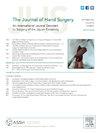手部手术后患者报告结果的自动化测量。
IF 2.1
2区 医学
Q2 ORTHOPEDICS
引用次数: 0
摘要
目的:本研究的目的是评估手部手术后接受电子患者报告结果测量(ePROMs)的患者的总体反应率,并确定与反应相关的患者特征。方法:根据《健康保险流通与责任法案》(Health Insurance Portability and Accountability act)的要求,开发了一个基于网络的系统,为5家机构22名外科医生的手部手术患者自动分发eprom。年满18岁的患者才符合条件。采用视觉模拟量表(VAS)评估疼痛和手臂、肩膀和手的快速残疾(QuickDASH)。术后3周、6周、12周、24周和52周,电子发送eprom和满意度问卷。结果:共有6458例患者符合条件。其中80%是自愿参加的。其中,70%的患者在术后至少一个时间点完成了eprom,而30%的患者没有完成任何eprom。在应答者中,28%的人完成了所有五个时间点,而72%的人完成了四个或更少的时间点。与完全应答者相比,不完全应答者更有可能被工人赔偿保险。与完全应答者相比,不完全应答者表现出更高的基线QuickDASH评分和相似的基线VAS。在随访期间,不完全应答者在所有时间点都表现出较差的VAS和QuickDASH评分。最后,与完全应答者相比,不完全应答者在所有时间点对手术的满意度都较低。结论:本研究表明,基于电子邮件的自动化ePROM系统可能是调查分发的有效方法。特别是对于简单的门诊手术,这项研究说明了从这些系统中获得的数据在临床应用的潜力。临床相关性:随着以价值为基础的系统的兴起,患者报告的结果测量继续在卫生保健中发挥越来越大的作用。电子prom是一种相对未开发的媒介,它可能为更有效地收集这些有价值的患者指标提供可行的替代方案。本文章由计算机程序翻译,如有差异,请以英文原文为准。
Automating Patient-Reported Outcome Measures Following Hand Surgery
Purpose
The purpose of this study was to assess the overall response rate of patients receiving electronic patient-reported outcome measures (ePROMs) following hand surgery and to determine the patient characteristics associated with responding.
Methods
A Health Insurance Portability and Accountability Act–compliant, web-based system was developed to automatically distribute ePROMs to patients undergoing hand surgery at five institutions with 22 surgeons. Patients who were at least 18 years old were eligible. The PROMs used were the visual analog scale (VAS) for pain and the Quick Disabilities of the Arm, Shoulder, and Hand (QuickDASH). After surgery, ePROMs along with a satisfaction questionnaire were electronically sent three, six, 12, 24, and 52 weeks after surgery.
Results
A total of 6458 patients were eligible. Of these, 80% were enrolled voluntarily. Among these, 70% completed ePROMs for at least one postoperative time point, whereas 30% did not complete any. Among responders, 28% completed all five time points, whereas 72% completed four or fewer time points. Incomplete responders were more likely to be insured by workers’ compensation when compared to complete responders. Incomplete responders exhibited higher baseline QuickDASH scores and similar baseline VAS compared to complete responders. During the follow-up, incomplete responders demonstrated worse VAS and QuickDASH scores at all time points. Finally, in comparison with complete responders, incomplete responders were less likely to be satisfied with their surgery at all time points.
Conclusions
This study demonstrates that automated email-based ePROM systems may be an effective method for survey distribution. Particularly for simple, outpatient surgeries, this study illustrates the potential for clinical use of the data obtained from these systems.
Clinical relevance
Patient-reported outcome measures continue to have an expanding role in health care with the rise of valued-based systems. Electronic PROMs are a relatively unexplored medium that may offer a viable alternative to more effectively collecting these valuable patient metrics.
求助全文
通过发布文献求助,成功后即可免费获取论文全文。
去求助
来源期刊
CiteScore
3.20
自引率
10.50%
发文量
402
审稿时长
12 weeks
期刊介绍:
The Journal of Hand Surgery publishes original, peer-reviewed articles related to the pathophysiology, diagnosis, and treatment of diseases and conditions of the upper extremity; these include both clinical and basic science studies, along with case reports. Special features include Review Articles (including Current Concepts and The Hand Surgery Landscape), Reviews of Books and Media, and Letters to the Editor.

 求助内容:
求助内容: 应助结果提醒方式:
应助结果提醒方式:


